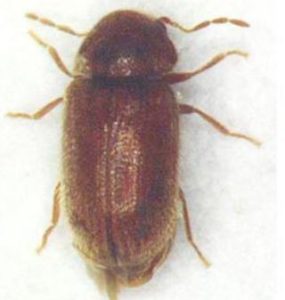Introduction to Mycotoxins

Mycotoxins are a naturally occurring chemical hazard in many agricultural commodities. The toxins are produced by certain molds which can grow on certain foodstuffs, including common staples in most diets like cereals, nuts, spices, dried fruits, apples, and coffee beans, often under warm and humid conditions. Mycotoxins can cause a variety of adverse health effects and pose a serious health threat to both humans and livestock. These adverse health effects can range from from acute poisoning to long-term effects such as immune deficiency and cancer.
Several hundred different mycotoxins have been identified, but the most commonly observed mycotoxins that present a concern to human health and livestock include aflatoxins, ochratoxin A, patulin, fumonisins, zearalenone and nivalenol/deoxynivalenol. It is important to note that mold that produces mycotoxins can grow on a variety of different crops and foodstuff and can penetrate deep into food and do not just grow on the surface.
Contaminated mycotoxins in foods and feeds should be removed, inactivated or detoxified by physical, chemical and biological means depending on the conditions. However, the treatment has its own limitations, since the treated products should be safe from the chemicals used and their essential nutritive value should not be deteriorated. Some mycotoxins require extreme heat to kill them so cooking should not be considered a common method for control.
Submitted by: Rich Gibson
ACE, CFSQA
Drugstore Beetle

Order: Coleoptera Family: Ptinidae Genus: Stegobium Species: S. paniceum
Adult Drugstore beetles are cylindrical, 2.25 to 3.5 mm long, and are a uniform brown to reddish brown. These beetles have longitudinal rows of fine hairs on the elytra (wing covers). Drugstore beetles are similar in appearance to the cigarette beetle; however, two physical characters can be used to tell the difference between them. The antennae of the cigarette beetle are serrated while the antennae of the drugstore beetle are not and end in a 3-segmented club. The other difference is that the elytra of the drugstore beetle have rows of pits giving them a striated (lined) appearance while those of the cigarette beetle are smooth.
Females lay up to 75 eggs in the food or substrate. The larval period ranges from four to 20 weeks. Larvae tunnel through the substrate and when fully grown build a cocoon and pupate. Pupation takes from 12 to 18 days. Adult females live approximately 13 to 65 days. The entire life cycle is generally less than two months but can be as long as seven months.
The drugstore beetle is a common pest of processed and packaged food products. It is found in flour mills, bakeries, pet food, breakfast cereal manufacturing, and snack food plants, chocolate factories, confectionaries, wholesale distribution centers and sometimes retail stores. Integrated pest management (IPM) programs are often implemented to control infestations at processing, distribution, and storage facilities.
Submitted by: Rich Gibson, ACE, CFSQA
German Cockroaches Everywhere
 The Service Supervisor of the Southern New Jersey and Pennsylvania Region was onsite at a client location to provide the routine service. Upon arrival, the client notified the Service Supervisor of some issues with German cockroaches in the production area. At that moment, the Service Supervisor asked the client if a walkthrough of the production could be undertaken in the area to assess the situation.
The Service Supervisor of the Southern New Jersey and Pennsylvania Region was onsite at a client location to provide the routine service. Upon arrival, the client notified the Service Supervisor of some issues with German cockroaches in the production area. At that moment, the Service Supervisor asked the client if a walkthrough of the production could be undertaken in the area to assess the situation.
During the inspection, it was evident that the client was dealing with a very serious problem. The German cockroaches were located around the conveyer systems. Specifically, large concentrations in the engine and motor housing. They were also located around and inside of the different pumps, hoses, tubes, and piping. Throughout the perimeter of the production area, they were in the cracks in the walls and behind and inside of all the electrical boxes. The client knew about the German cockroaches but didn’t know the extent of the infestation. The Supervisor spent about an hour with the client and maintenance to try and diagnose all the problem areas.
The client then began to ask a plethora of questions regarding mitigation of the German cockroaches. The Supervisor started to explain the different managed solutions that RK Environmental Services (RKE) has to offer. Spray treatments and baiting was not going to be enough to solve the German cockroach issues. The next step was to discuss the managed solutions. The supervisor then listed three plans of action for the next step in the process. The three plans of action were fogging and microinjection treatments, Vap-X treatment, or fumigation.
For this specific situation, the number one plan of action was to complete a fumigation of the production area. The fumigation would almost guarantee that all life stages of the German cockroach would be diminished. The Vap-X treatment would be highly effective as well but would not penetrate all the necessary areas needed to mitigate the issue. The fogging and micro-injection treatment could help mitigate the issues, but only if the treatments were done directly into the problem areas. Once the client understood all the possible solutions, he wanted to know pricing for the fumigation and how soon the service could be completed.
The Supervisor had a call with the management team and the Fumigation Manager to formulate an exact action plan for this facility. After completing a second inspection and getting the measurements of the production area, a managed solution proposal was sent directly to the client. Due to the seriousness of the issues, the client was more than happy to sign
this managed solution. Once the proposal was signed, the RKE Team immediately began to plan for the fumigation.
Due to this location being a production plant, the RKE Team was able to schedule the service to be completed on the weekend. The three steps that we took to complete the fumigation included sealing, letting off the gas, and aeration. After the aeration process was completed, we walked the production area so we could tell exactly where the German cockroaches were located. We then let the client know a plethora of areas they needed to fix and seal in order to prevent another infestation. The client was very happy with the results of this fumigation. The fumigation took place in the summer months of 2020 and to this day, the client has not had any additional German cockroach issues.
Take Away Points:
1. Inspect all areas of the facility.
2. Discuss RKE’s managed solutions with the client.
3. Close gaps and openings to exclude pests.
4. Tailor programs to fit specific needs.
Submitted by Brandon Duffy
Service Supervisor
RK Environmental Services, LLC






